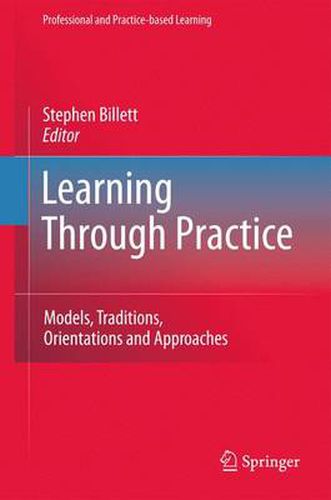Readings Newsletter
Become a Readings Member to make your shopping experience even easier.
Sign in or sign up for free!
You’re not far away from qualifying for FREE standard shipping within Australia
You’ve qualified for FREE standard shipping within Australia
The cart is loading…






This title is printed to order. This book may have been self-published. If so, we cannot guarantee the quality of the content. In the main most books will have gone through the editing process however some may not. We therefore suggest that you be aware of this before ordering this book. If in doubt check either the author or publisher’s details as we are unable to accept any returns unless they are faulty. Please contact us if you have any questions.
Practice-based learning-the kind of education that comes from experiencing real work in real situations-has always been a prerequisite to qualification in professions such as medicine. However, there is growing interest in how practice-based models of learning can assist the initial preparation for and further development of skills for a wider range of occupations. Rather than being seen as a tool of first-time training, it is now viewed as a potentially important facet of professional development and life-long learning. This book provides perspectives on practice-based learning from a range of disciplines and fields of work. The collection here draws on a wide spectrum of perspectives to illustrate as well as to critically appraise approaches to practice-based learning. The book’s two sections first explore the conceptual foundations of learning through practice, and then provide detailed examples of its implementation.
Long-standing practice-based approaches to learning have been used in many professions and trades. Indeed, admission to the trades and major professions (e.g. medicine, law, accountancy) can only be realised after completing extended periods of practice in authentic practice settings. However, the growing contemporary interest in using practice-based learning in more extensive contexts has arisen from concerns about the direct employability of graduates and the increasing focus on occupation-specific courses in both vocations and higher education. It is an especially urgent issue in an era of critical skill shortages, rapidly transforming work requirements and an aging workforce combined with a looming shortage of new workforce entrants. We must better understand how existing models of practice-based learning are enacted in order to identify how they can be applied to different kinds of employment and workplaces. The contributions to this volume explore ways in which learning through practice can be conceptualised, enacted, and appraised through an analysis of the traditions, purposes, and processes that support this learning-including curriculum models and pedagogic practices.
$9.00 standard shipping within Australia
FREE standard shipping within Australia for orders over $100.00
Express & International shipping calculated at checkout
This title is printed to order. This book may have been self-published. If so, we cannot guarantee the quality of the content. In the main most books will have gone through the editing process however some may not. We therefore suggest that you be aware of this before ordering this book. If in doubt check either the author or publisher’s details as we are unable to accept any returns unless they are faulty. Please contact us if you have any questions.
Practice-based learning-the kind of education that comes from experiencing real work in real situations-has always been a prerequisite to qualification in professions such as medicine. However, there is growing interest in how practice-based models of learning can assist the initial preparation for and further development of skills for a wider range of occupations. Rather than being seen as a tool of first-time training, it is now viewed as a potentially important facet of professional development and life-long learning. This book provides perspectives on practice-based learning from a range of disciplines and fields of work. The collection here draws on a wide spectrum of perspectives to illustrate as well as to critically appraise approaches to practice-based learning. The book’s two sections first explore the conceptual foundations of learning through practice, and then provide detailed examples of its implementation.
Long-standing practice-based approaches to learning have been used in many professions and trades. Indeed, admission to the trades and major professions (e.g. medicine, law, accountancy) can only be realised after completing extended periods of practice in authentic practice settings. However, the growing contemporary interest in using practice-based learning in more extensive contexts has arisen from concerns about the direct employability of graduates and the increasing focus on occupation-specific courses in both vocations and higher education. It is an especially urgent issue in an era of critical skill shortages, rapidly transforming work requirements and an aging workforce combined with a looming shortage of new workforce entrants. We must better understand how existing models of practice-based learning are enacted in order to identify how they can be applied to different kinds of employment and workplaces. The contributions to this volume explore ways in which learning through practice can be conceptualised, enacted, and appraised through an analysis of the traditions, purposes, and processes that support this learning-including curriculum models and pedagogic practices.